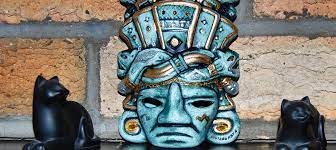The rare blue the Maya invented

In 17th-century Europe, during the time Michelangelo Merisi da Caravaggio and Peter Paul Rubens were producing their celebrated masterpieces, the pigment ultramarine blue—derived from the semi-precious lapis lazuli stone—was sourced from distant mines in Afghanistan and valued more highly than gold. Access to this rare and costly material was limited to elite painters, while less renowned artists had to rely on cheaper, less vibrant pigments that quickly faded under sunlight. It wasn’t until the Industrial Revolution in the 19th century that a synthetic version was developed, making true ultramarine blue widely accessible.
Meanwhile, across the Atlantic, colonial Baroque artists in early 17th-century Mexico—then known as New Spain—such as José Juárez, Baltasar de Echave Ibia, and Cristóbal de Villalpando, were creating vivid works rich in brilliant blue. This seemed puzzling given the extreme rarity of lapis lazuli in the Americas. The mystery wasn’t solved until the mid-20th century, when archaeologists discovered that the Maya had developed a durable and luminous blue pigment centuries before colonization—what we now know as Maya blue.
Unlike the costly and labor-intensive ultramarine in Europe, blue in Europe was reserved for sacred subjects, like the Virgin Mary’s robes or royal figures, as seen in Rubens’ Adoration of the Magi at Madrid’s Museo del Prado—a painting he labored on for over two decades. In contrast, artists in colonial Mexico used blue more liberally and for everyday subjects.
Archaeological investigations of Mesoamerican ruins in present-day Mexico and Guatemala, particularly in the Maya Riviera, revealed murals dating back as far as 300 AD. One of the most well-known examples, from the temple at Chichén Itzá (c. 450 AD), demonstrated the ceremonial importance of blue to the Maya. According to 16th-century colonial bishop Diego de Landa Calderón, Maya rituals involved painting altars and sacrificial victims in this striking blue.
Researchers were intrigued by the pigment’s remarkable resistance to fading. While the region had abundant añil (indigo) plants, commonly used for dyeing, indigo-based paints normally deteriorated quickly in sunlight. It wasn’t until the 1960s that scientists discovered the secret of Maya blue’s longevity: a unique blend of añil dye and attapulgite, a rare clay. Like all indigenous materials and knowledge, Maya blue was later exploited during colonization, becoming part of the vast plundering of the New World.
A symphony in blue
Despite their brilliance, Baroque painters from the Americas are often overlooked in global art history, dismissed as imitators of European masters like Caravaggio and Rubens. However, artists such as Juárez and Echave Ibia—born and raised in Mexico City—developed a distinctive style that departed from European traditions. Their work evolved into rich, complex compositions filled with vibrant colors and local influences. At Mexico City’s National Art Museum (Munal), Juárez’s artistic growth is evident: from early European-inspired works to bold canvases filled with saturated blues, yellows, and greens, featuring multiple light sources, grand scales, and composite structures—thanks in part to materials like Maya blue.
Rubens also favored intense colors, but his compositions were often more chaotic and warmer in tone than Juárez’s cooler, more structured works. Though Juárez used an even more vivid palette than Rubens, his compositional style was closer to Caravaggio’s. Interestingly, Caravaggio rarely used blue; his works are dominated by reds and yellows. Juárez’s blue-toned works could be considered the closest equivalent to a “blue Caravaggio,” yet he died in poverty. This raises a crucial question: if he lacked wealth, how could he have imported large amounts of lapis lazuli from Europe?
Villalpando, recognized as one of New Spain’s most prolific painters, more closely emulated Rubens’ dynamic, image-dense compositions. He adhered to the Baroque principle of filling every inch of the canvas—a “fear of emptiness”—and was thus more readily accepted by traditional art historical narratives as a representative of Novohispanic Baroque painting. However, despite his European aspirations, Villalpando used Mesoamerican materials and indigenous labor. His paintings retained the cooler, more saturated tones characteristic of the region, such as in the mural he painted on the dome of Puebla Cathedral, where swirling blue and purple clouds surround religious figures. Though he sought to create European Baroque in the Americas, his local materials revealed his identity as a criollo—someone of Spanish descent born in the colonies.
Baltasar de Echave Ibia, nicknamed El Echave de los azules (Echave of the Blues), was celebrated for his mastery of blue tones. His father, Baltasar de Echave Orio, also made frequent use of blue, but it was Ibia who became known for his distinctive, abundant use of the color. Unlike in Europe, Ibia had a plentiful supply of brilliant blue, sourced locally rather than imported.
While written documentation about the use of añil or Maya blue in New Spanish Baroque art is limited, the visual evidence is undeniable. These colonial artists were clearly not using the same ultramarine made from lapis lazuli as their European counterparts. Instead of the deep, dark ultramarine typical in European works, the blue used in the Americas was the vivid azure of Maya origin. Maya blue—resilient and luminous—still endures in 1,600-year-old murals at Chichén Itzá. Its durability likely contributed to the lasting vibrancy of Baroque paintings across the Americas, from Mexico to Peru, preserving their color for centuries.
